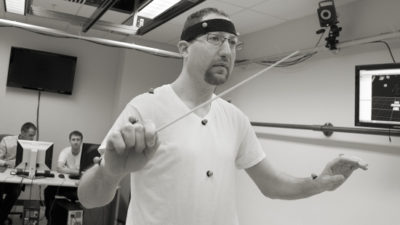Conservatory Uses Data for Pilates Therapy
Philip Edelman works through the motions like a seasoned pro.
A doctoral student in the University of Missouri-Kansas City’s Conservatory of Music and Dance, Edelman moves his conductor’s baton at a steady 80 beats per minute. He looks almost serene.
But Edelman isn’t in his element. The room is silent and the musicians he’s directing are nonexistent.
Cameras surround him from nearly every angle. Small, bulbous sensors stick to his skin. The four highly sensitive scales at his feet track his weight as he shifts and leans. Nearby, a mounted computer screen captures the scene: Edelman’s form, represented by bright white dots, swings and sways on an otherwise black screen.
Edelman is one of several doctoral-level Conservatory students who, in the fall semester, volunteered to be monitored in the School of Computing and Engineering’s (SCE) Human Motion Laboratory.
The reason? Conducting is a pain.
“If you’re conducting a 40-minute work and you have bad posture, you’ll be in pain when it’s over. Most of us have bad posture. We spend a lot of time with our heads in the score, so we get a habit of hunching over to watch the music and watch the kids too,” Edelman said.
He has always responded to those twinges with a wince and a few Advil. He’s not alone. Professor of Instrumental Studies Steven D. Davis has seen firsthand the long term effects of using a reactive approach to pain management.
“This is a recognized issue in the conducting community. We see a lot of injuries, particularly to the rotator cuff, neck and even low back and shoulders. Sometimes these issues manifest in actual tangible injuries to more mature conductors. That’s why injury prevention is key,” Davis said.
Thanks to this collaboration between the Conservatory of Music and Dance and the School of Computing and Engineering, Edelman and a handful of other students will soon combat the pain in a more proactive way. Gregory King, an assistant professor of Civil and Mechanical Engineering, and SCE mechanical engineering graduate student Elliott Goff, spent the fall semester collecting baseline data on the conductors. They monitored the students’ every move, using the Human Motion Laboratory’s equipment.
They used that information to pinpoint exactly what habits – a stretch here, or a strain there – are causing the conductor’s pain. The data was then given to Associate Professor of Dance Sabrina Madison-Cannon.
She uses the report to develop customized Pilates based exercises that are designed to foster better posture and ease pain.
“Pilates is designed to even out muscular imbalances which are the cause of many postural deviations. You can customize exercises to target weak muscles or muscle groups, and lengthen tight areas by working through a full range of motion,” Madison-Cannon said.
It’s a tactic she uses frequently with her dance students. When Professor of Instrumental Studies Steven Davis heard of Madison-Cannon’s success, he asked if she could do the same thing for his conducting students. Her answer: Why not?
The decision to involve the Human Motion Laboratory was an easy one. Certified Pilates instructors are trained to do a postural analysis of their clients, but the visual assessments they do can only go so far. Data from the Human Motion Laboratory tells a more complete story.
“The goal is to assess where they are now and create a person-specific Pilates routine. We’ll bring them in again later this spring, when they’re about halfway through with their Pilates intervention to see if there is any improvement over what we measured last semester,” King said.
Madison-Cannon is currently meeting with the students three times per week to oversee their individually tailored Pilates exercises. In late March, King, Madison-Cannon and Davis plan to present their preliminary findings at the College Band Directors National Association Southwest Regional Conference at the University of Arkansas.
The project has proved to be plenty of work, but if it helps conducting students like Edelman, the professors say it’s worth a shot.

